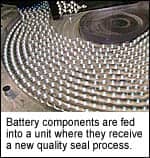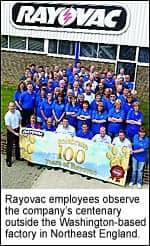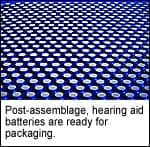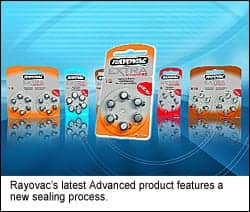Rayovac is introducing its latest zinc air battery to the European marketplace.

Rayovac’s desire to improve and innovate has led the firm to work closely with all the major device manufacturers throughout the world in developing products with the intention of better meeting consumers’ needs. “Because the development of new battery technology is directly linked to what is happening in the hearing aid market, it is vital to have open and honest dialogue with device manufacturers,” says Gerry Allchorne, divisional vice president of Rayovac. “In recent years, technological changes have resulted in battery sizes becoming smaller, something that has placed a premium on superior performance and reliability. It is in this area that Rayovac has worked closely with the industry, in order to anticipate the technology and power requirements of new hearing aid devices.”
And Rayovac’s batteries continue to increase in power output. When the company introduced its size 10 batteries in 1986, they contained 50 milliamp hours. That same size battery today has 105 milliamp hours—an increase of more than 100% in the same amount of space. “Hearing aids are performing better than ever before, and one of the key reasons for this is that we’ve dramatically increased the capacity of the power source from what it was two decades ago,” says Allchorne.
The company draws not only on the latest improvements in hearing battery power technology to meet the needs of the market, but on a century-long history as well.
The “French” Connection
Rayovac was founded in 1906 in Wisconsin, United States of America. Originally called the French Battery Company, the company began by developing dry cell batteries using a secret formula that mixed electrolytes with zinc, called the “French process.”
A decade or so later, the French Battery Company began producing a battery for radios using vacuum tubes. Dubbed the “Rayovac”—after the technology used to power it—the battery became so successful that by the 1930s, the company changed its name to Rayovac.
After briefly manufacturing hearing aids in the 1930s—before giving away the patent—Rayovac concentrated its energy on providing hearing aid batteries. This concentration led half a century later to its presence in Europe and across the globe. Rayovac now sells its products in 120 countries and 1.2 million stores throughout the world.
European Presence
Rayovac’s operations in Europe are headquartered at its manufacturing plant at Washington in Northeast England, which employs a workforce of 150. The site is also the headquarters of Rayovac’s worldwide parts production. “We’ve invested heavily in new technology to improve the manufacturing and testing process so that our customers enjoy the best possible product. Washington is a key center in the Rayovac chain, providing batteries for Europe and the Far East—one of our many growing markets,” says Glen Rutherford, plant manager at Rayovac’s Washington base. The company is a relatively new player in the European market. It opened its Washington plant in the early 1980s.

The need for greater power and smaller batteries has brought major changes in battery technology—transforming the market since Rayovac first ventured into Europe.
Technological Advances
The first hearing aid batteries were manufactured in the 1950s after new transistor technology allowed miniaturization of the devices. Rayovac developed a “button” cell, called this because of its size and shape. These early devices were powered using mercury- and silver-based chemicals. It was not until the late 1970s that zinc air batteries were introduced. And although Rayovac was not among the first zinc air manufacturers, it quickly joined the market.

The digital revolution has been the primary driver of changes in the marketplace. Digital aids now account for 89% of the European market. However, the wide acceptance of digital devices has come at a price: increasing the power demands of devices from a cut-off point of 0.9V for analog to 1.1V for digital.
A Wide Range of Power
Today, the typical voltage of zinc air cells is 1.4V, although many technical variables can affect the power delivered by the battery. This is the area of cell design and technological innovation where Rayovac has worked hard to create proprietary differences and improvements in battery performance.

In addition, there is a size 5 battery introduced in 1995 for people with very small ear canals. These batteries are not as popular, due to the difficulty of handling them and the limitations on power as a result of the very small size.
The performance of hearing aid batteries is integral to the operation of the device. Rayovac believes that its new Advanced battery line will increase the performance of the instruments in which it is used.
On the Advance
The Advanced features patented cell construction and components that together provide more power and increased life across all batteries. For example, in the 312-size category, using advanced performance testing criteria proposed by the IEC, the new cell has up to 17% greater power. This is particularly relevant in higher demand aids—primarily digital devices and those used by those with severe hearing loss—where users previously had to settle for shorter battery life as a trade-off for more power.
A new sealing process has also been introduced, eliminating electrolyte migration and thereby enhancing battery shelf life by 33%. The zinc capacity of the battery has also been increased, with mAh ratings on key battery sizes up by as much as 10% versus prior product. The battery also has a 4-year freshness date code.

With such developments, the future looks bright for Rayovac. The good news for them and for other hearing aid battery manufacturers in Europe is that the market looks set to continue its present upward trend.
Bright Future
Figures from 2005 indicate growth in the hearing aid device market of 4.9% in Western Europe, up from less than 2% in 2004. The biggest growth areas appear to be the United Kingdom, the Netherlands, Switzerland, Italy, and Norway—arguably a result of greater private involvement and binaural use.
N.L. Shepherd is a contributing writer for Hearing Products Report.





